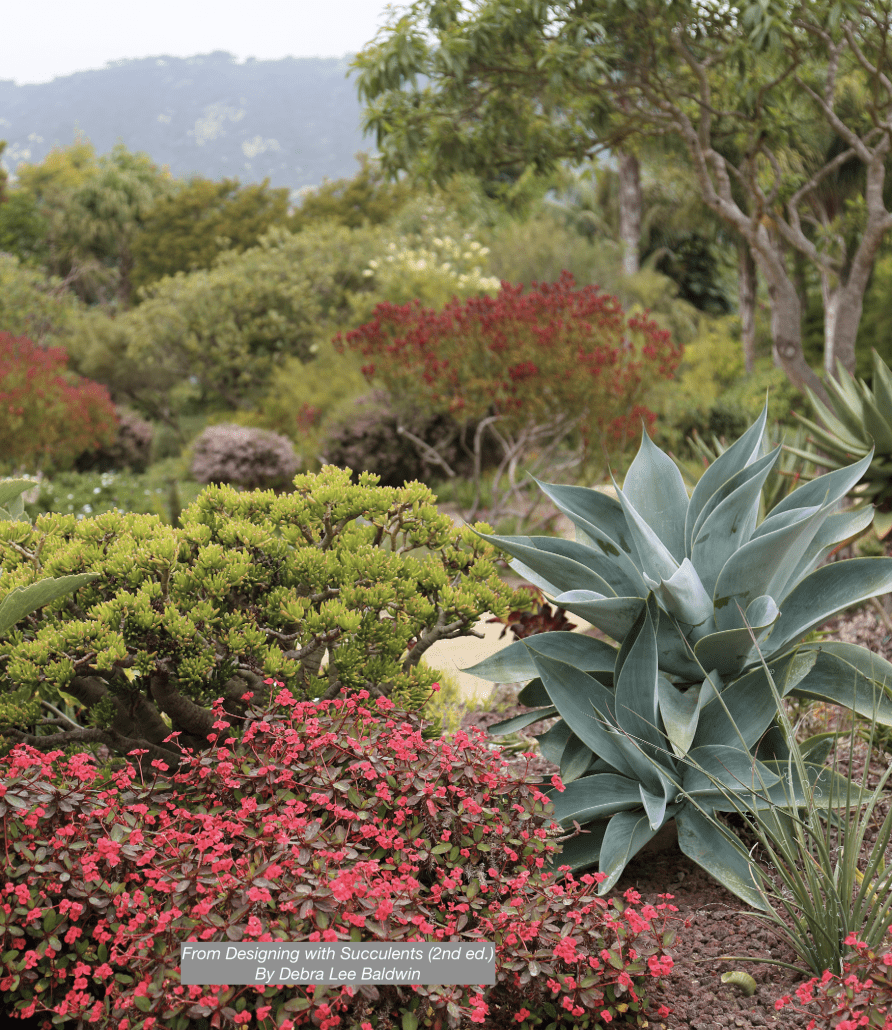
Agaves Handle Summer Heat
Late summer is when tough succulents really shine. Large agaves handle summer heat, and are unfazed by harsh sun, high temps and lack of rain. Their statuesque, fountainlike forms lend a sculptural element to any landscape, and contrast beautifully with fine-textured ornamentals. They also make good firebreak plants and security fences.
With the exception of a few soft-leaved and variegated varieties, agaves want sun—the more the better in all but desert climates. Most are hardy to the mid- to high-20s F, and some go a lot lower.
Sharp points at leaf tips and along leaf edges can make agaves treacherous. I snip about a quarter inch from leaves’ needlelike tips with garden shears.
Agaves smaller than basketballs make excellent potted plants. Small agaves—there are many exquisite ones—look good displayed one to a pot.

Agaves with serpentine terminal spines and prominent teeth along leaf margins are both graceful and fierce. Don’t they remind you of how cats yawn and show their fangs?

Scalloped patterns on an agave’s leaves (“bud imprints”) are caused by spines and teeth pressing into the flesh of inner leaves before they unfurl. Aren’t they fascinating?
When pruning a damaged leaf, keep in mind that a straight-across cut at its midsection may spoil an agave’s symmetry. It’s best to make two cuts that trim the leaf to a “V” that resembles the leaf’s natural tip. Or cut it all the way to the trunk.
One of the most common agaves, A. attenuata (foxtail agave) has soft, smooth, nonspiny leaves that are prone to sun scorch in summer and frost burn in winter. Damaged tips will collapse and turn white. If this has happened to yours, watch my short video on how to trim them.
Large agaves that pup (not all do) can be thugs. They’ll grow and spread rapidly, especially when given good soil and regular irrigation. One of the most widely grown is A. americana (century plant), because it offsets so prolifically (free plants!) and needs no care at all…until those pups start to get big and form an unruly, ever-expanding colony.
Because it seems that everyone is blithely planting Agave americana these days, agave expert Kelly Griffin and I made a video that gives better choices for the long run: Six Great Agaves for Your Garden. It’s the sequel to What You MUST Know About Century Plants (Agave americana).
Being indigenous to the New World (the American Southwest, Mexico and Central America), larger agaves store enough moisture to get by on rainfall alone and will thrive in nutrient-poor soils. Although agaves like water, their roots—like those of most succulents—will rot in waterlogged soil.
All but a few agaves are monocarpic, meaning they bloom once and then die. This may take as many as 25 years, but it will happen. As it completes its life cycle, a mature rosette that has graced a garden for years sends up an asparagus-like flower stalk (most, but not all, branch). This dwarfs the plant and saps its energy. Flowers along the stalk eventually turn into miniplants (bulbils) or seed capsules.

Only the individual agave that flowers dies. In some cases—notably with those involving Agave americana—a litter of pups will carry on.
The above is edited from the intro to Agaves in “Succulents A to Z” in Designing with Succulents (2nd ed.). The book, which also covers Aloes among 30 important genera of succulents, includes photos and descriptions of significant varieties, and shows how to grow and use them beautifully in gardens and landscapes.
Also see Succulents Simplified, pp. 177-184; this site’s Agave page; and my YouTube channel‘s Agave playlist.





I have 6 large Agave Blue Flame, 4 have flowered in the last year and are now dying. There are pups and what looks like additional flowers coming out of the dying plants. My question is how do I harvest the pups? They are popping out in the middle of the mother plant, not at the base. I’ve searched the internet and youtube but from what I’ve found there is a lack of information on flowering Blue Flame. Wish I had done some more videos on them!
I have pictures if that would help.
Thanks for any advice you can give.
Hi Karen — The mother plant is going to die, so when you remove it, you should be able to cut out the pups and plant them. Does that help?
Thanks, I’ll need to wait a bit. Although they are dying the mothers still look pretty good and the pups continue to grow. It will be nice to be able to replace the mothers with their own babies. 🙂
Debra my Blue Glow Agave was turning yellow and flopping so I thought perhaps With our monsoons it had gotten to much water or not enough water since it hadn’t rained in awhile. Upon closer inspection you were correct, it had Agave Snout Weevil large. They look exactly like your photos on your website. When I tried taking the agave out it pulled apart and there were the grubs. They had eaten through the roots. I sent you photos so you could see them. Thank you for your advise Debra. I took your advise earlier in the spring and used a systemic on all my agaves but I must have missed this one. I really loved this agave.
I’m so sorry to hear it, Michele. Every so often I find an agave that I’ve missed, too, and that the weevil found. For those interested, here’s the link to the snout weevil page.
What does it mean when the agave leaves go white
Frost or sunburn. It’s common on foxtail agaves (Agave attenuata) because of their thin leaves. Trim the leaves to a point, rather than straight across, to preserve the aesthetics of the plant.
My Agave (Americana I think, it’s blue green and very thorny along the edge) is turning yellow and so are the surrounding pups that I dug up and moved outward away from the mom. I read to spray them with epsom salts, but now I think another person said some sort of weevel or grub? How can I tell what it is? HELP. I want to save them if possible.